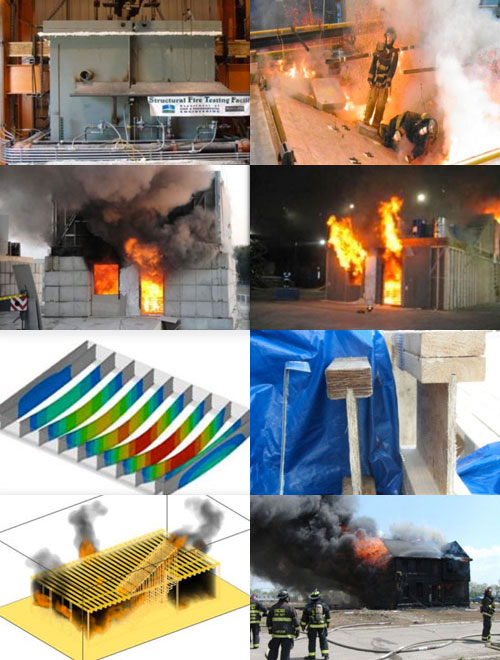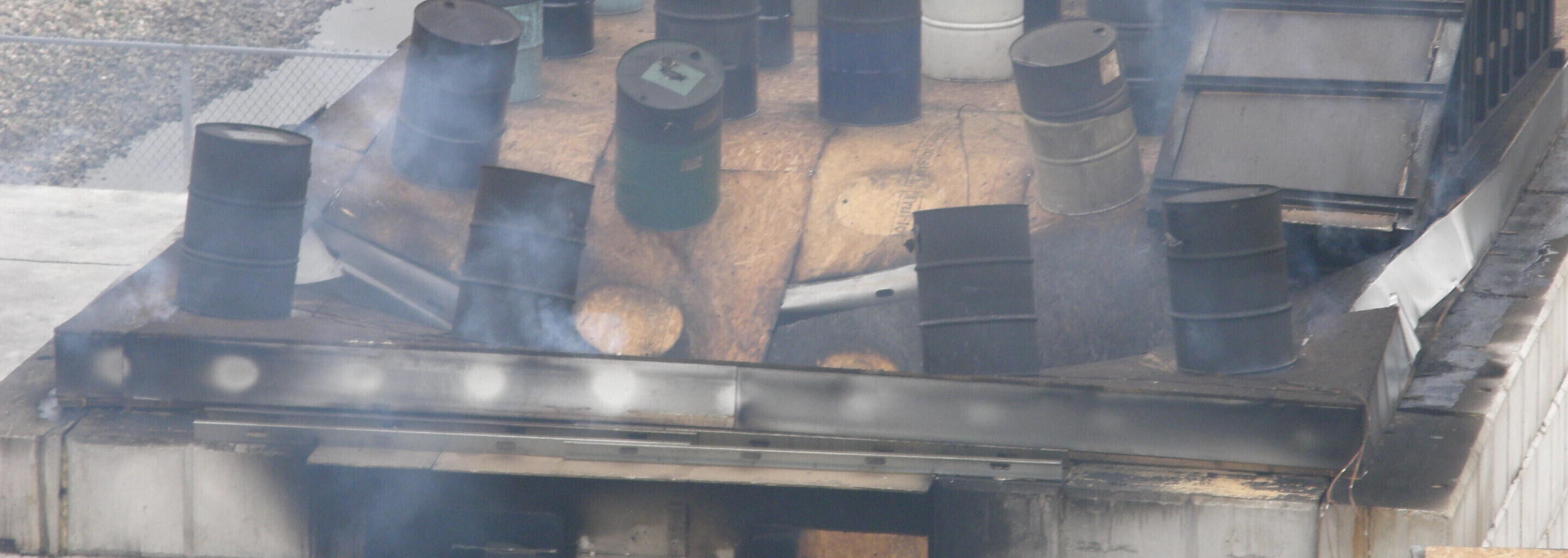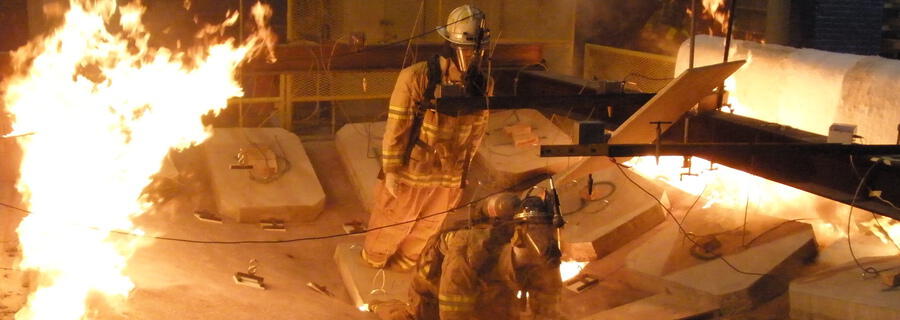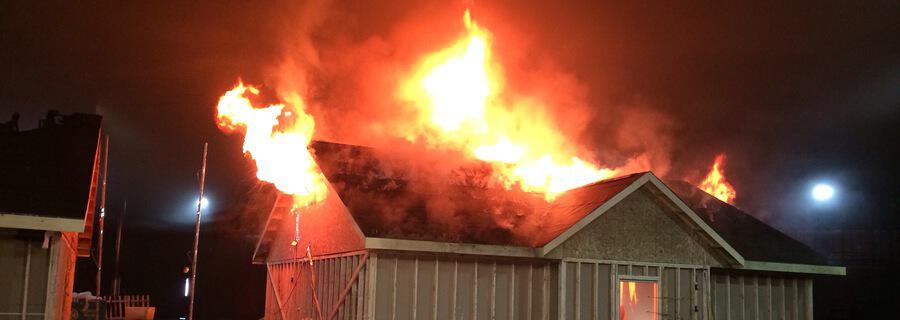This project was a collaboration of several research organizations, product manufacturers and fire service representatives to examine hazards associated with residential flooring systems to improve firefighter safety. Funding for this project was provided through the National Institute of Standards and Technology’s American Recovery and Reinvestment Act Grant Program.
The main objective was to improve firefighter safety by increasing the level of knowledge on the fire response of residential flooring systems. Several types (or series) of experiments were conducted and analyzed to expand the body of knowledge on the impact of fire on residential flooring systems. The results of the study provide tactical considerations for the fire service to enable improved decision-making on the fire scene.
Experiments were conducted to examine several types of floor joists including, dimensional lumber, engineered I-joists, metal plate connected wood trusses, steel C-joists, castellated I-joists and hybrid trusses. They were performed at multiple scales to examine single floor system joists in a laboratory up through a full floor system in an acquired structure. Applied load, ventilation, fuel load, span and protection methods were altered to provide important information about the impact of these variables to structural stability and firefighter safety.
Tactical Considerations
Tactical considerations firefighters can use immediately to improve their understanding, safety and decision-making when sizing-up a fire in a one or two family home:
- Collapse times of all unprotected wood floor systems are within the operational time frame of the fire service regardless of response time.
- Size-up should include the location of the basement fire as well as the amount of ventilation. Collapse always originated above the fire and the more ventilation available the faster the time to floor collapse.
- When possible the floor should be inspected from below prior to operating on top of it. Signs of collapse vary by floor system; Dimensional lumber should be inspected for joist rupture or complete burn through, Engineered I-joists should be inspected for web burn through and separation from subflooring, Parallel Chord Trusses should be inspected for connection failure, and Metal C-joists should be inspected for deformation and subfloor connection failure.
- Sounding the floor for stability is not reliable and therefore should be combined with other tactics to increase safety.
- Thermal imagers may help indicate there is a basement fire but can’t be used to assess structural integrity from above.
- Attacking a basement fire from a stairway places firefighters in a high risk location due to being in the flow path of hot gases flowing up the stairs and working over the fire on a flooring system which has the potential to collapse due to fire exposure.
- It has been thought that if a firefighter quickly descended the stairs cooler temperatures would be found at the bottom of the basement stairs. The experiments in this study showed that temperatures at the bottom of the basement stairs where often worse than the temperatures at the top of the stairs.
- Coordinating ventilation is extremely important. Ventilating the basement created a flow path up the stairs and out through the front door of the structure, almost doubling the speed of the hot gases and increasing temperatures of the gases to levels that could cause injury or death to a fully protected firefighter.
- Floor sag is a poor indicator of floor collapse, as it may be very difficult to determine the amount of deflection while moving through a structure.
- Gas temperatures in the room above the fire can be a poor indicator of both the fire conditions below and the structural integrity of the flooring system.
- Charged hose lines should be available when opening up void spaces to expose wood floor systems.
During all of these experiments where the variables were systematically controlled, there were no reliable and repeatable warning signs of collapse. In the real world, the fire service will never respond to two fires that are exactly the same. On the fire ground there are many variables to consider and most of the parameters being considered are often unknown which makes decision making that much more difficult. Information such as how long the fire has been burning, what type of floor system, was it built to code or altered at any point, is it protected with gypsum board, what is the loading on the floor and how long is the span are all unknown to the responding firefighters. There are also no collapse indicators that guarantee the floor system is safe to operate on top of. Sounding the floor, floor sag, gas temperatures on the floor above and thermal imager readings even when taken all together do not provide enough information to guarantee that the floor will not collapse below you. Flooring system components and floor covering materials are composed of materials that work to limit the flow of thermal energy through them. As a result flooring materials could be on fire on the bottom side (basement side) while only exhibiting modest temperature increases on the top side of the floor.
In addition, rapid changes in fire dynamics can result from flow paths created by ventilating the basement and first floor of a structure. These flow paths combined with the fast spreading fire that results from the ignition of an unprotected wood floor system can place firefighters on the floor above the fire in a vulnerable position with little time to react. It is acknowledged that there are times where firefighters may choose to operate on top of a basement fire to carry out their life safety mission however this decision must be made understanding the potential for catastrophic consequences. There are also alternative tactics to consider in order to control the fire without first committing crews above the fire such as suppression initiated from a basement window or doorway. Coordination to control the basement fire prior to opening the first floor and committing crews on the first floor is essential.
Appendices:
Appendix A: Fire Resistance Tests on Wood and Composite Wood Beams
Appendix B: Fire Service Collapse Hazard Floor Furnace Experiments
Appendix C: Full-Scale Floor System Field and Laboratory Fire Experiments
Appendix E: Modeling the Thermal and Structural Behavior of Wood Beams in a Fire Environment
Appendix F: Fire Modeling of Basement with Wood Ceiling





